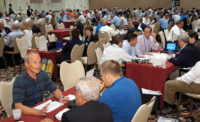Manufacturers Foresee Continued Growth In 2005, But A Slowdown In Capital Expenditures
The panel of purchasing and supply executives expects a 7.8 percent net increase in overall revenues for 2005, compared to an increase of 8.3 percent increase reported for 2004.
“At present, the manufacturing sector continues to recover from major influences that stalled growth early in the millennium,” said Business Survey Committee Chairman Norbert Ore. “Manufacturing seemingly has reasonable momentum at this point, with continuing strength in new orders and production, and is in its 18th consecutive month of growth.”
Manufacturer executives predict that capital expenditures will increase only 1.6 percent in 2005, compared to the 15.1 percent increase reported for 2004. The report for 2004 significantly exceeds panel members' expectations as they predicted an increase of only 6 percent for 2004 in the April 2004 forecast.
The 42 percent of members expecting to spend more on capital expenditures in 2005 predict an average increase of 23.4 percent. However, 21 percent expect a decrease averaging 38 percent. Considering the 37 percent who expect to spend the same on capital expenditures in both years, the overall net average change forecast for 2004 is an increase of 1.6 percent.
Price, Technology Trends
They predict the prices they pay will increase 4.3 percent during the first four months of 2005, and will increase an additional 0.1 percent for the balance of 2005. After an initial forecast in December 2003 of a slight increase in prices paid during 2004, purchasers stated their expectation of a larger increase (7.6 percent) in ISM's April 2004 report. They now report an expected increase of 11.2 percent for all of 2004.A special question was asked to determine the respondents' progress in achieving efficiency from the application of technology to supply management. While a few companies rate themselves as being almost finished, 82 percent are less than three-fourths complete in achieving efficiency from the application of technology, while 47 percent indicate they are less than 50 percent complete. Members expect to realize supply chain improvements through supplier relationship enhancements; process, tools, systems, and software improvements; and the application of electronic commerce.
Summarizing revenues for 2004, 70 percent say revenue was better than 2003, and their nominal (before adjusting for inflation) revenues increased an average of 14.3 percent. Conversely, 14 percent say their nominal revenues decreased in 2004 by an average of 13 percent, and the remaining 16 percent indicate no change.
Purchasers forecast that revenues will be strong in 2005 compared to 2004. The 75 percent of members forecasting better business in 2005 than in 2004 estimate an average nominal (before adjusting for inflation) increase of 12.2 percent in their companies' revenues. This compares to an average nominal decrease of 21.1 percent forecast by the 6 percent who predict lower revenues in 2005. Including the 19 percent who see no change in 2005, the forecast for overall net nominal growth in business revenues for 2005 over 2004 is 7.8 percent.
Survey respondents report that profit margins have declined on average during the second and third quarters of 2004 as 34 percent experienced an increase in profit margins, while a larger number (42 percent) had lower margins, and 24 percent reported no change. However, their expectations are for significant increases between now and April of 2005 as 39 percent predict better profit margins (an increase of 5 percentage points), 21 percent predict lower margins (a decrease of 21 percentage points), and 40 percent predict no change (an increase of 16 percentage points).
Purchasing and supply executives are slightly more optimistic about the second half of 2005 compared to the first half of the year.
Manufacturer Concerns
It has been quite some time since inflation has led the list of concerns, but it is definitely back and a concern to survey members. Energy, one of the major drivers of inflation, ranked second among their concerns. A weak economy is the next concern followed by effects of war and geopolitical concerns; and labor, benefits and healthcare costs, including labor shortages, complete the list. While the list is quite broad, the responses are dominated by concerns focusing on cost pressures and supply chain constraints.Sidebar: Snapshots of ISM Manufacturer Survey
- Operating rate is currently 83 percent of normal capacity.
- Capital expenditures increased 15.1 percent in 2004.
- Capital expenditures will increase 1.6 percent in 2005.
- Production capacity will increase 5.6 percent during 2005.
- Prices paid increased 11.2 percent during 2004.
- Overall 2005 prices will increase 4.4 percent from 2004.
- Labor and benefits costs will increase at a 3.4 percentage rate in 2005.
- Manufacturing employment will increase 1.6 percent in 2005.
- The U.S. dollar is expected to strengthen somewhat against currencies of major trading partners.
- Expect strong export growth in 2005.
- Expect strong import growth in 2005.
- Manufacturing revenues (nominal) are up by 8.3 percent in 2004.
- Manufacturing revenues (nominal) will be up by 7.8 percent in 2005.
- Major concerns to manufacturers: prices and inflation; energy price increases; weak economy; effects of war and geopolitical concerns; and labor, benefits and healthcare costs, including labor shortages.
- Overall attitude of manufacturing management - optimistic, not as strong as December 2003, but still very upbeat.
Looking for a reprint of this article?
From high-res PDFs to custom plaques, order your copy today!








